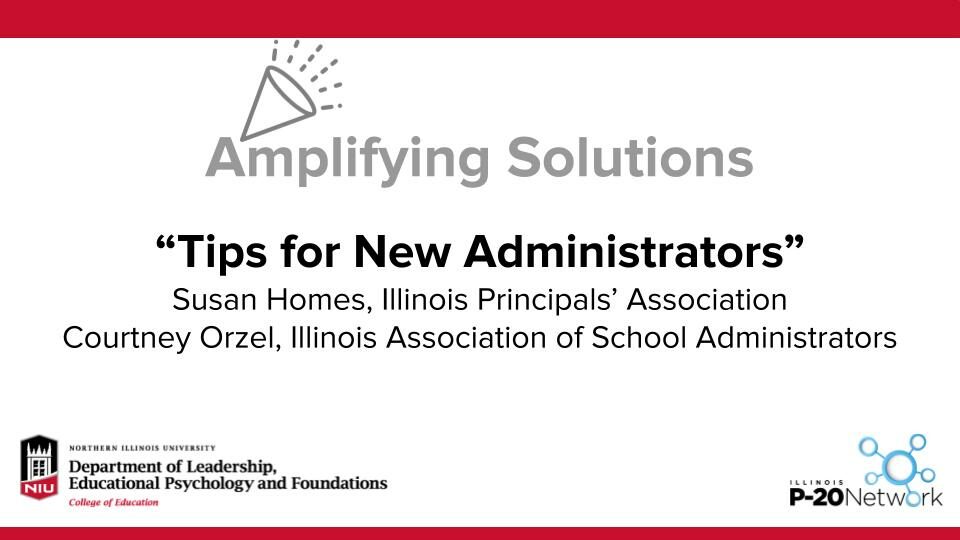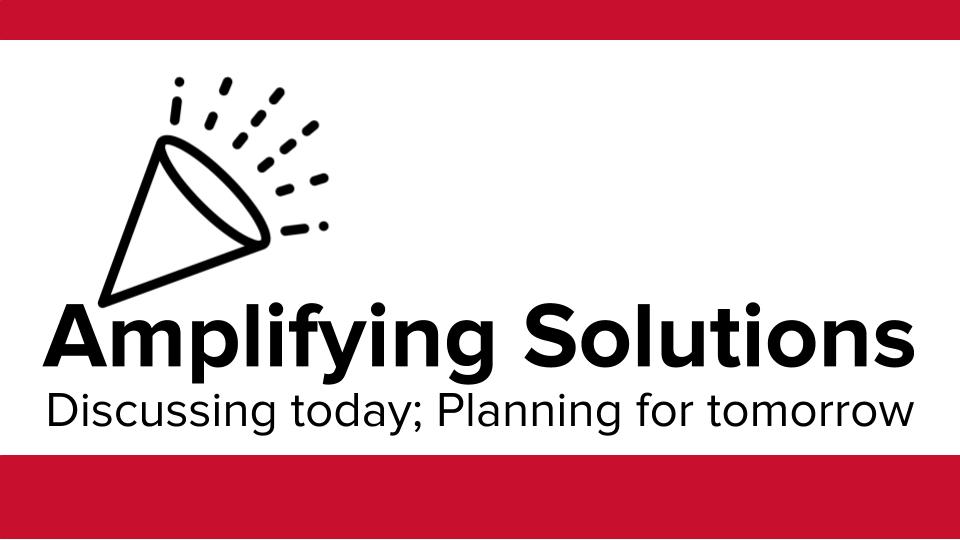
Amplifying Solutions – Tips for New Administrators

Each episode of Amplifying Solutions focuses on questions and challenges from practitioners, primarily current graduate students earning their degrees to become the next generation of principals, school business leaders, and superintendents, as well as those students who are earning their doctoral degrees. In response to these questions, experts are brought together to discuss solutions and strategies. The complete video conversation is included below.
In this episode of Amplifying Solutions, Dr. Susan Homes from the Illinois Principals’ Association and Dr. Courtney Orzel from the Illinois Association of School Administrators discuss tips to help new school leaders, as well as veteran administrators, be successful. While the context is specifically geared toward the COVID-19 pandemic, as is discussed in the video, these tips are relevant and applicable at any time.
The same keys to success
While the COVID-19 Pandemic presents unique challenges that have placed tremendous stress on school systems and all of the individuals in them, from students and families to teachers and staff to school administrators, Dr. Homes and Dr. Orzel point out that the keys to being successful during the Pandemic are the same keys to being successful at any time. These include:
- Build relationships first – Be certain to know people as individuals, to understand and appreciate the community (or in many cases, the various communities that make up a school or district), learn the politics and dynamics of decision-making, and establish trust, respect, and fairness.
- Be genuine – People, including students, see through ego and falsehoods. Identify your core values and stick to them. (One tip is to ask your immediate family what they think your core values are, and you can check their answers against your own. Their answers are likely to reveal patterns in your daily actions.)
- Personalize the work – Students and staff members alike will learn more and do better when work has been personalized according to their needs and interests. Ask students and staff members directly about their needs and interests, and then follow-through to make adjustments based on what they have told you.
Taking care of yourself
It has become a common refrain to tell leaders to take care of themselves and to remind leaders that they cannot be successful for others if they are not staying well. At the same time, for many school administrators knowing that this is true is one thing while putting it into practice on a consistent, ongoing basis is much more difficult. Some tips include:
- Take advantage of professional resources focused on wellness – For example, IASA has launched its Mindfulness Matters series for its members.
- Find your group – Connect with colleagues who face the same challenges and pressures and be there to support one another. Text each other to simply see how others are doing. Call a colleague to check-in on the way to or from work. Make these routine parts of your day.
- Hold each other accountable for being well – Take a few minutes and eat your lunch. Drink water throughout the day. Exercise and know that the time you are spending doing so will help you be more productive and more positive (and more likely to stay well physically, too). Along with the colleagues in the aforementioned group, remind one another to take these steps each day. Ask each other if you did. If not, help brainstorm how to do so tomorrow.
Get important things done – and done well
With the busy competing demands that school leaders face, prioritizing is always important, and during the Pandemic, it is more important than ever. Schools and districts must continually ask themselves, “What are our most important goals and needs for students?” Then, when faced with new or additional requests, it is critical to ask, “Will this new task still allow me to focus on successfully accomplishing the priorities that we set?”
To help ensure that you follow through with the priorities, some of the suggestions in the video include the following:
- Use your calendar – Block out the time in your calendar to complete the tasks that are your priorities. If being in classrooms (in-person or remote/online) is an important part of your plan to improve student learning, time to be in classrooms must be blocked out in your calendar and maintained as a priority.
- Work with your colleagues – Most schools and districts are full of dedicated, smart people. As a school or district leader, you do not have to know or do everything. Share work with your colleagues wherever and whenever it is appropriate with their jobs. At the same time, you have to balance this by also protecting their time as the leader to ensure that they can maintain their focus on completing the tasks that align with the organization’s priorities for students.
- Follow-through – The work does not get done if you do not follow-through and complete it. This also includes being sure to close communication loops, so teachers and staff, families, and students know that the work is complete.
Looking to the future
In thinking about the long-term lessons from COVID-19 and the changes that schools can and should implement, Dr. Homes and Dr. Orzel identified the following key points:
- Identify what is most important and focus on those priorities
- Doing less will result in doing more
- Focus on equity and ensuring that real opportunities are available for all students and for each student
- Emphasize personalization to make learning meaningful and to ensure that everyone feels connected and part of their school community
- Identify the strengths of the school or district, and then work hard to do those things even better
- Focus on supporting teachers–They have the biggest impact on student learning
- Trust that educators can do great work regardless of where they are in their career journey – from their first year to their last year
- Emphasize the importance of adaptability for all educators
Resources
- Manage Your Time or Time Will Manage You: Strategies that Work from an Educator Who’s Been There by Meridian CUSD223 Superintendent Dr. PJ Caposey
- Onward: Cultivating Emotional Resilience in Educators by Elena Aguilar
- The Onward Workbook: Daily Activities to Cultivate Your Emotional Resilience and Thrive by Elena Aguilar
- 100-Day Leaders: Turning Short-Term Wins into Long-Term Success in Schools by Douglas Reeves & Robert Eaker

